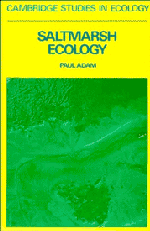Book contents
- Frontmatter
- Contents
- Preface
- Abbreviations for frequently-occurring species names
- 1 General features of saltmarshes and their environment
- 2 The saltmarsh biota
- 3 Variation in saltmarsh vegetation
- 4 Coping with the environment
- 5 Plant life history studies
- 6 Saltmarshes as ecosystems
- 7 Modification, management and conservation
- References
- Index
5 - Plant life history studies
Published online by Cambridge University Press: 04 April 2011
- Frontmatter
- Contents
- Preface
- Abbreviations for frequently-occurring species names
- 1 General features of saltmarshes and their environment
- 2 The saltmarsh biota
- 3 Variation in saltmarsh vegetation
- 4 Coping with the environment
- 5 Plant life history studies
- 6 Saltmarshes as ecosystems
- 7 Modification, management and conservation
- References
- Index
Summary
Despite long-term successional processes, plant communities on most saltmarshes appear to be stable over many years. The little information on the longevity of saltmarsh plants suggests that, at many sites, communities may be stable for periods longer than the lifespan of their individual components. Any understanding of the processes involved, both in the maintenance of communities and the transition between communities, will require knowledge of the regeneration niche (Grubb 1977, 1986) of saltmarsh species. The concept of the regeneration niche encompasses ‘the requirements for effective seed set, characteristics of dispersal in space and time, and requirements for germination, establishment and onward growth that have to do not only with gap shape and size, but also with weather, pests and diseases.’ (Grubb 1986).
At the present time, it would not be possible to provide a fully comprehensive account of the regeneration niche of any saltmarsh species, although data on Salicornia spp. (see pp.330–334) are sufficient to define several components of the niche. The regeneration niche may be unique to genotypes, and so is not necessarily constant across the whole range of a species. Given the great intraspecific genetic diversity within species (pp. 107–131), life history characteristics are likely to be as much subject to variation as other traits. In the case of A. tripolium, within a single marsh there can be variation from long-lived perennials in the low marsh to short-lived perennials (or even annuals) in the upper-marsh (pp. 112–114).
- Type
- Chapter
- Information
- Saltmarsh Ecology , pp. 309 - 334Publisher: Cambridge University PressPrint publication year: 1990
- 1
- Cited by

